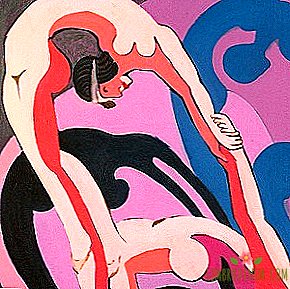Art Therapy: What and how to treat paints and romance novels
The world is gradually getting used to the fact that mental disorders - This is serious, and even in a light form, they need correction. Treatment in this case may be not only in conversations with a psychotherapist or medication. The human brain responds to the impact of art - based on this art therapy and bibliotherapy. We tried to understand how the treatment works with books and works of art, and discussed the impact of art on mental health with the psychotherapist Zoya Bogdanova.

The influence of art on the emotional state of man was noticed, probably, by cavemen who began to depict mammoths on the walls. Much has been written and told about how painting or music can change a life (and not just an artist or a performer) - and it’s not surprising that people try to use art specifically to get the desired effect. Art therapy is used by psychotherapists for various diseases, and psychologists. There are even associations of art therapists.
Art therapy has almost no scientifically based evidence of effectiveness, including due to the complexity of its study: it is difficult to conduct a comparative study of treatment methods based on an individual approach. Nevertheless, observational data and their analysis show: it works. When a person is engaged in creativity, he is immersed in the process and is left alone with himself, focuses on the present, learns to express himself and becomes acquainted with his inner world, splashes out emotions and controls them. Treatment with art covers different areas, and it is much broader and more interesting than the use of colorings for stress relief.
Psychotherapist Zoya Bogdanova says that art therapy includes many methods associated with creativity. Expression of feelings and emotions through drawing or painting is an isotherapy, and any technique can be, from classical to drawing with fingers and splashing paint. This type of art therapy is the only one that has no contraindications, and it is used in centers of help to victims of violence or to patients with cancer.
In isotherapy, they do not paint pictures as such, the main goal is to express their state of mind: emotions, feelings and sensations. It does not need the idea of the canvas or the talent of the artist; but the color of the paint used is important, for example. The promise that a professional can decipher is important. Bogdanova notes that if a person does not understand what to draw and how it can help, then the problem may lie in a specialist - he must adhere to the method of therapy and be sure to prepare patients. The therapist is the conductor of a person in a state where he is ready to transfer his inner world to a sheet of paper.
Art therapy is not such a harmless thing, as it seems, and in some cases can aggravate the situation. Restrictions, for example, exist for people who have suffered a severe stroke, for patients with severe rehabilitation, children with cerebral palsy, and people with bipolar disorder. For these groups of patients phototherapy is quite effective - a method that allows you to look at yourself from the outside. A person together with a specialist analyzes the stages of his life through pictures, examining the details, how the emotional state was expressed at a certain point in time, what kind of people surrounded him, their postures and relationships.
For example, clay therapy is also considered to be a creative form of art therapy. For modeling, not only ordinary clay, but also polymer clay or clay can be used, and the resulting “hand-made article” reflects the emotional state of a person. There is sand therapy, dramatherapy, doll therapy, kinotherapy - and this list continues to grow.

Bibliotherapy is also a way to cope with internal problems, only with the help of books. People who like to read, probably themselves noticed a special influence of the text on the consciousness and even behavior. Some works are so powerful that they change a person’s life - and this is not only about religious or motivational books that contain direct calls to action or instructions. It’s just that sometimes after reading we can’t get a new idea out of our head or our eyes open and we look at things from an unexpected angle.
Bibliotherapy is not as researched as other methods, it definitely does not have such an evidence base as in cognitive-behavioral therapy, or a powerful system and school, as in psychoanalysis. But the benefit of a large text for mental health was noticed a long time ago: Pharaoh Ramses II had a library called the “Temple of Healing the Soul”, and Sigmund Freud, who turned the concept of mental disorder therapy, included work with books in his method, and the term appeared in 1916 year
Bibliotherapy is based on the fact that after talking with the patient the therapist selects books that can positively affect the state: they will show how to cope with the problem, imbue them with the necessary emotions or allow them to disconnect from current difficulties. As a rule, reading is followed by analysis and discussion - sometimes in groups. The choice of books in this case is limited only by the characteristics of the person and the diagnosis of the patient. For example, Yanagihara's "Little Life" at the height of the depression may be too difficult a choice.
Popular science literature does not always raise the spirits and stifles anxiety, but it can help to figure out what is happening - like, for example, the publication “Go crazy! A mental disorder guide for a big city resident” Darya Varlamova and Anton Zaitsev. But most often to restore the psyche still use fiction. When patients read about heroes, especially in situations similar to ours, they look at problems from a different angle. Empathy for the characters is a way to throw out emotions, similar to the effect of isotherapy. For those who just do not have enough emotions (for example, these are people in a state of depression, in which the world seems gray), the text can become a source of "lost" feelings.
In Russia and earlier in the USSR, library science was based, of course, on the classics, which is irrelevant today. Not only that many books from the school curriculum in themselves can bring to neurosis, they also do not reflect modern realities. Perhaps this is why we know little about bibliotherapy, although this is a good way to cope with anxiety and depression, which works as an addition to the main treatment regimen. In any case, it is worth picking up books with a specialist who will take into account the state and characteristics of the patient.
A book that helps to deal with internal conflicts and disorders does not have to be particularly deep, problematic, or even clever. The popularity of romance novels with an unpretentious plot lies precisely in this deliberate simplicity with an indispensable, in spite of everything, happy ending. Daria Dontsova, whose detectives were not scolded, seems to be only lazy, not for nothing that the book calls "depression pills." A writer who has experienced the experience of a serious illness actually speaks of the therapeutic effects of creativity (even if someone else's). Bibliotherapy is also used for children, whom reading and detailed analysis of fairy tales helps to understand their emotions.
Treatment with art and literature is one of the most inexpensive, but at the same time effective ways to cope with some manifestations of disorders, especially on the part of mood. Therapy with creativity helps to understand emotions, bibliotherapy teaches one to look at what is happening or to be distracted from hard thoughts. The main thing is that both types can always be used together with the main treatment, both pharmacological and "conversational."
Zoya Bogdanova advises to be attentive to the choice of a psychotherapist, even if you want to try such a seemingly simple method as art therapy or reading books. It is better to choose certified professionals who have acquired a profession in an accredited institution - this may be a university or state advanced training courses. They give basic knowledge of psychological counseling and art therapy in particular. As for other types of therapy, you need to look at customer reviews, analyze the practice of the doctor, if possible look for recommendations. It happens that the young therapist, despite his limited experience, has the knowledge and desire to work with modern methods - and the psychotherapists of the “old school” do not practice phototherapy, according to Bogdanova.
Photo:Africa Studio - stock.adobe.com, Marek Walica - stock.adobe.com, david_franklin - stock.adobe.com




